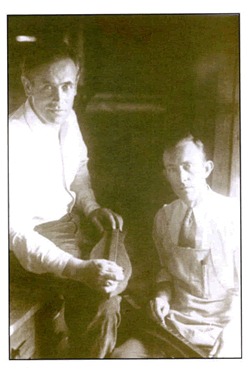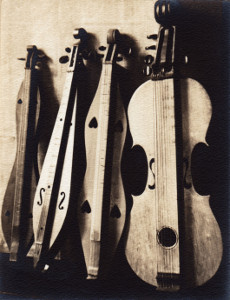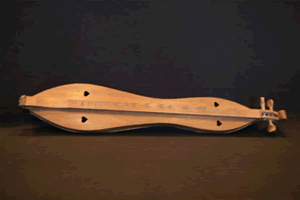Instruments:
Dulcimer
The fretted dulcimer of the Craft Revival period was a hand-made wooden instrument often played by its maker as an accompaniment to sung hymns or ballads. This dulcimer or dulcimore is also referred to as a hog fiddle, music box, scattlin 1, and Appalachian, mountain, or lap dulcimer. 2
The origin of the name—dulcimer—is said to be a combination of the Latin word dulce (sweet) and the Greek word melos (song/tune.) 3 Makers of the fretted dulcimer tended to be rural folks who picked up constructing and playing the instrument as a pastime. These craftsmen often intended to create a singer’s “companion,” often played in the maker’s home as a personal companion to the rich tradition of balladry in the Appalachian South.
The characteristically gentle but arresting sound of a dulcimer is produced by plucking its strings with a thumb, a wooden plectrum, or goose quill, while the instrument itself lies across the player’s lap. A dulcimer’s silhouette can vary from maker to maker and it’s construction uses simple tools. Sometimes like a tear drop, sometimes a long rectangle up to a yard in length, the instrument’s shape is flexible. For decorative purposes, the sound holes also vary; perhaps hearts, circles, diamonds or a more ornate design. The capacity of the sound resonation, though, depends upon choices of material. Dulcimers have been crafted from well-dried walnut, maple, birch, yellow pine, cedar, poplar, white oak. 4 Each wood produces a slight variation in the instrument’s sound.
While the dulcimer’s basic design is similar to another instrument, the Zither, commonly found in northern Appalachia, it remains a unique object due to the innovation and creativity allowed by its freedom of design. 5 More often than not, the Southern Appalachia instruments varied from one another in shape and sound-hole selection, as described above, but also in string number and size. 6 For this reason, some historians debate whether the Revival-period dulcimer could have been constructed from a faint memory of another instrument.

The characteristically unique fretted dulcimer also differed vastly from any manufactured counterpart. While the mass-produced instruments utilized a preconceived design pattern, both the design—and sound—of fretted dulcimers were often times revealed after their construction. 7
There are few instruments in circulation today that were made prior to the turn of the 20th century. J. E. “Uncle Eddy” Thomas is one of the most notable and prolific makers of the fretted dulcimer during the Craft Revival Period. Thomas may have crafted nearly 1,500 instruments during his working years, 1871 – 1933. He exemplifies the essence of the Craft Revival period as an innovative instrument maker who was able to earn a living creating a hand-made product that utilized his special skills. 8
- Jada Hansen
See More: Dulcimers
1. Michael Murphy, The Appalachian Dulcimer Book, (Ohio: Folksay Press, 1976) 12.
2. Joe Wilson, The Blue Ridge Music Center: A Place Near the Heart. (Silver Spring, MD: National Council on the Traditional Arts, 2000) 32.
3. Murphy, 20.
4. Allen Eaton, Handicrafts of the Southern Highlands, (New York: Russell Sage, 1937) 203-204.
5. L. Allen Smith, Catalogue of Pre-Revival Appalachian Dulcimers, (Columbia: University of Missouri Press, 1982), 1-2; referencing Charles Seeger’s, “The Appalachian Dulcimer” from the Journal of American Folklore 71 (January-March 1958) 49.
6. Eaton, 20
7. Jean Ritchie explains the different outcomes in dulcimer sound in an introduction to Smith, Catalogue, x. See also Ritchie’s own story in Jean Ritchie, Singing Family of the Cumberlands (NY: Oxford, 1955).
8. Smith, 10.





